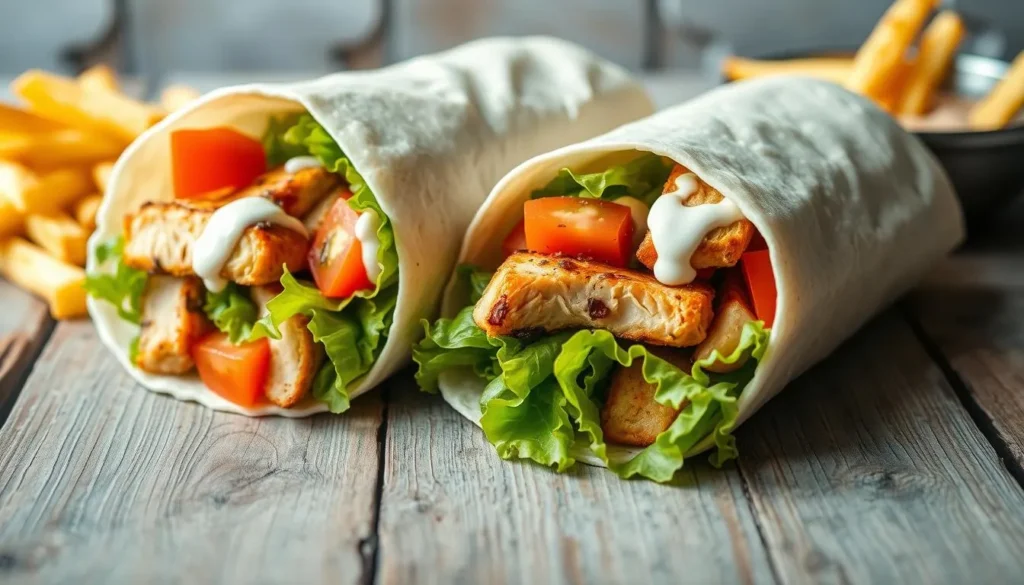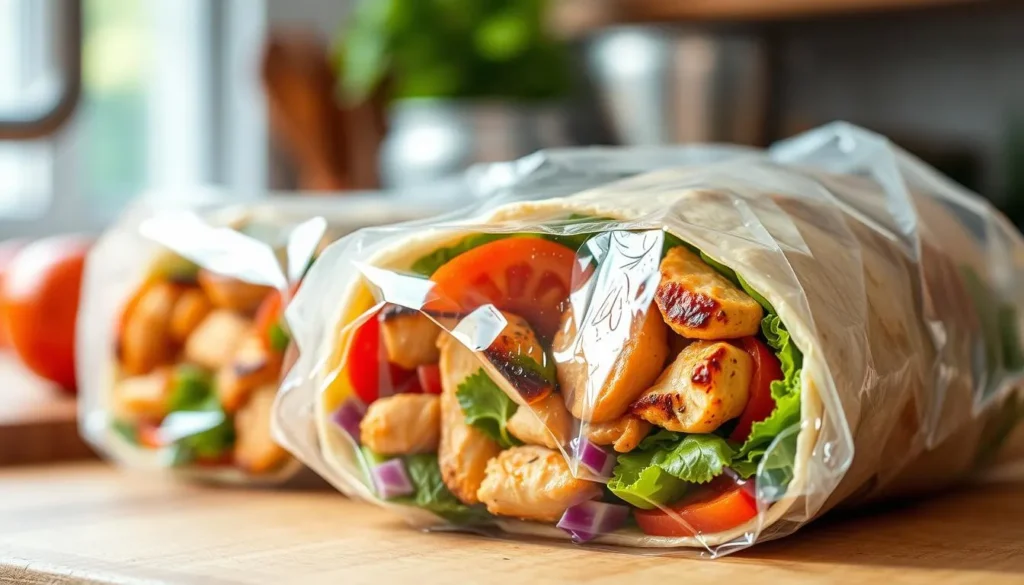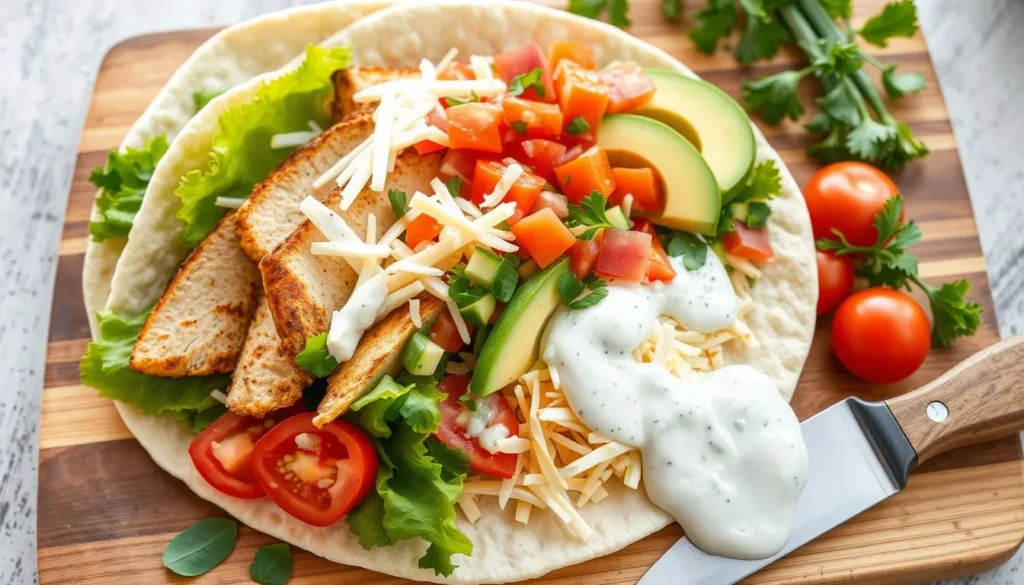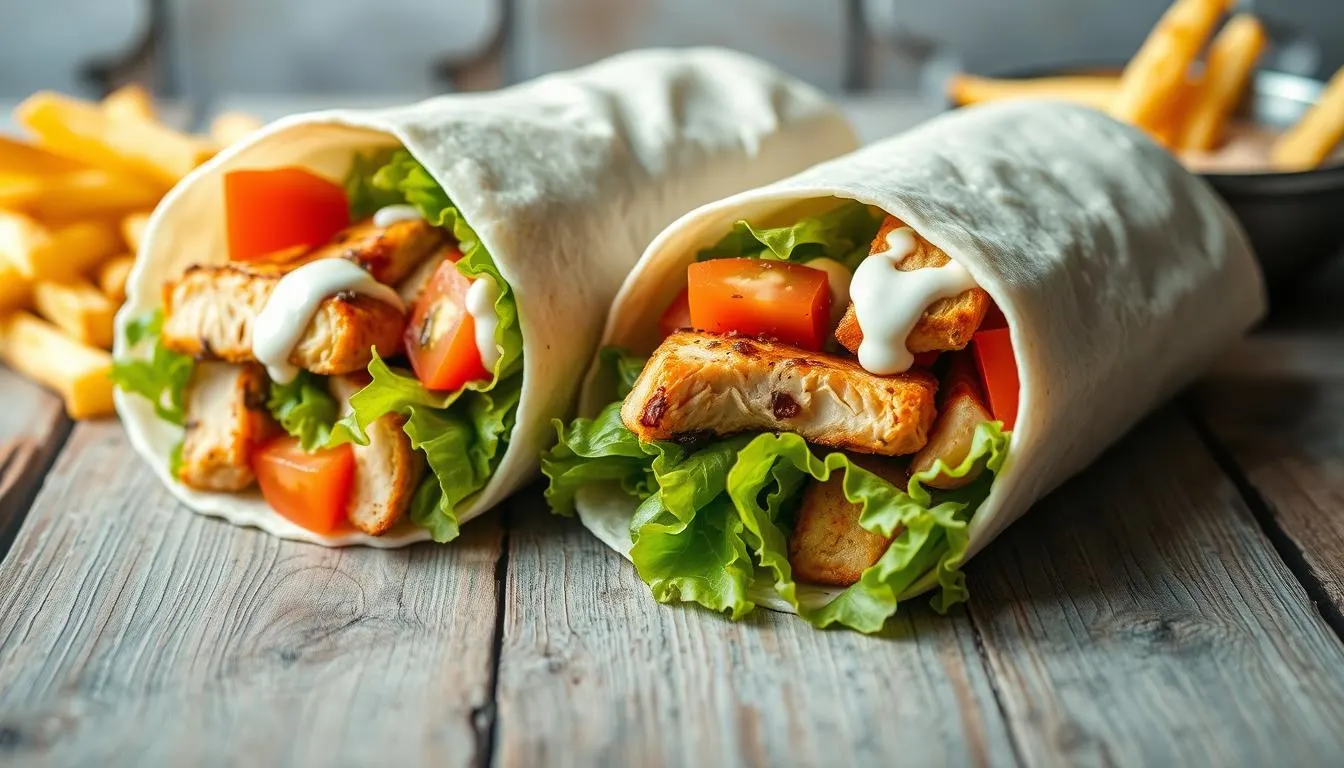Ever bitten into a chicken wrap and found it soggy? It’s a letdown that can spoil a tasty meal. I’ve had my share of soggy wraps, but I’ve found ways to keep them fresh and crispy. In this article, I’ll share my tips to enjoy your homemade chicken wraps without the sog.

Key Takeaways
- Understand the science behind soggy wraps and how to prevent it
- Discover the essential ingredients and techniques for moisture-resistant wraps
- Learn the proper way to prepare chicken filling and assemble the perfect wrap
- Explore storage and transportation methods to keep your wraps fresh and crisp
- Avoid common mistakes that can lead to a soggy disaster
Understanding the Science Behind Soggy Wraps
Making the perfect chicken wrap is more than picking the right ingredients. It’s about managing moisture. Knowing about temperature, water release, and condensation helps keep your wraps fresh.
The Role of Moisture and Temperature
Moisture can ruin a crisp wrap. Heat and air make ingredients release water, making wraps soggy. It’s key to understand how moisture and temperature work together.
Why Ingredients Release Water
Ingredients vary in water content and how fast they release it. For example, tomatoes and cucumbers are very wet. Chicken also releases moisture when cooked or thawed. Knowing this helps you make better wraps.
Heat and Condensation Effects
Temperature changes can make moisture problems worse. Heat makes water evaporate and then condense, making wraps damp. Keeping the right temperature is crucial.

Understanding why wraps get soggy helps you make them stay fresh. Learning about moisture-proof wrapping and wrap storage tips is key. This way, you can always serve delicious chicken wraps.
Essential Ingredients for Creating Moisture-Resistant Wraps
Making the perfect chicken wrap is more than just picking the right wrap ingredients, wrap toppings, and wrap fillings. You must choose and prepare each part carefully. This ensures your wrap stays crisp and fresh.
Moisture-absorbing veggies are key. Shredded cabbage, julienned carrots, or diced cucumber soak up extra moisture. This stops the wrap from getting soggy. Also, using drier cheeses like feta or cheddar helps keep moisture out.
Preparing the chicken filling is crucial. Grilling, searing, or roasting the chicken removes excess moisture. This makes the chicken drier and more compact. Seasoning the chicken with spices and herbs adds flavor and helps keep the wrap dry.
| Ingredient | Moisture-Resistant Properties |
|---|---|
| Shredded Cabbage | Absorbs excess moisture |
| Julienned Carrots | Crisp, crunchy texture |
| Diced Cucumber | Helps create a moisture barrier |
| Feta Cheese | Drier and more compact texture |
| Grilled or Seared Chicken | Removes excess moisture for a drier filling |
By carefully choosing and preparing your wrap ingredients, wrap toppings, and wrap fillings, you can make a chicken wrap that stays crisp and fresh. It will stay this way even hours after you make it.

“The secret to a perfect wrap is in the preparation of the individual components. Each element plays a crucial role in maintaining the overall integrity of the dish.”
How do you keep Chicken Wraps from getting soggy?
To make delicious chicken wraps, it’s important to prevent them from getting soggy. Use smart ways to layer ingredients, create barriers, and manage temperature. This way, your wraps will stay fresh and crispy.
Proper Ingredient Layering Techniques
The way you layer ingredients affects the wrap’s texture and moisture. Start with the chicken at the bottom. Then add crunchy veggies like shredded lettuce or carrots. This creates a barrier against moist ingredients.
Finally, add sauces or dressings on top. Make sure they’re spread out evenly. This prevents them from making the wrap soggy.
Creating Moisture Barriers
- Use a thin layer of a moisture-wicking ingredient, such as shredded cabbage or a flour tortilla, to act as a barrier between the fillings and the wrap.
- Lightly toast or grill the tortilla or wrap before assembly to help crisp it up and prevent it from becoming soggy.
- Blot any wet ingredients, like marinated chicken or diced tomatoes, with a paper towel to remove excess moisture before adding them to the wrap.
Temperature Management Tips
Keeping the right temperature is key for your chicken wraps. Don’t let them sit at room temperature for too long. This can cause them to become soggy. Assemble the wraps just before eating and store them in the fridge.
When you’re on the go, use insulated bags or containers. This keeps the wraps cool and prevents the fillings from getting soggy.
“The key to keeping chicken wraps crisp and fresh is to focus on controlling moisture and temperature throughout the entire process, from preparation to storage and transport.”
Best Practices for Preparing Chicken Filling
Making the perfect fresh chicken wraps begins with the chicken filling. To keep your wraps crisp and tasty, follow these tips for preparing the chicken.
Achieve the Perfect Texture
Start by cooking the chicken until it reaches 165°F (74°C). Don’t overcook it, as this can make it dry and tough. For a juicy filling, try poaching or sautéing the chicken instead of baking.
Enhance Flavor with Seasoning
Boost the flavor of your crispy wrap techniques by seasoning the chicken. Use herbs and spices like garlic, cumin, chili powder, or citrus zest. This will make the chicken taste great with the other wrap ingredients.
Proper Cooling Technique
After cooking, let the chicken cool down completely before making the wraps. This step helps avoid sogginess. Spread the chicken on a baking sheet or plate and let it cool to room temperature before using it.
| Technique | Benefit |
|---|---|
| Poaching Chicken | Maintains juiciness and tenderness |
| Seasoning with Spices | Enhances flavor and aroma |
| Allowing Chicken to Cool Completely | Reduces excess moisture for a crisp wrap |
By using these tips for preparing the chicken filling, you’ll make fresh chicken wraps that are full of flavor. They’ll stay crispy from start to finish.
Strategic Layering Order for Wrap Assembly
Making the perfect chicken wrap begins with the right order of ingredients. Knowing the best way to layer them helps avoid sogginess and keeps the texture great. Let’s look at the main points for building your wrap.
Protective Ingredient Placement
Start with a crunchy base like lettuce or a strong tortilla. This layer protects the rest from getting too wet. It keeps your wrap from getting soggy.
Moisture-Heavy Components Positioning
Then, place your wrap ingredients with high moisture in the middle. This includes tomatoes, grilled chicken, or sauces. This way, moisture spreads out, avoiding soggy spots.
Optimal Sauce Distribution
For sauces and dressings, aim for a thin, even layer. Avoid big pools that can make the wrap soggy. The right wrap assembly order ensures great flavors and textures in every bite.
Using these layering tips, you can make chicken wraps that stay fresh and tasty. Learning the wrap assembly order is key to serving crisp, flavorful wraps every time.
Selecting the Right Type of Tortilla or Wrap
Choosing the right tortilla or wrap is key to a perfect chicken wrap. It’s all about avoiding sogginess and keeping it crispy. There are many options, each with its own moisture-proof properties and texture.
Flour tortillas soak up more liquid than corn tortillas, making them soggy. But, moisture-proof wrapping like whole wheat or multigrain tortillas can keep your chicken filling crisp.
| Tortilla Type | Moisture-Resistance | Texture |
|---|---|---|
| Flour Tortilla | Moderate | Soft and pliable |
| Corn Tortilla | High | Firm and crispy |
| Whole Wheat Tortilla | High | Slightly chewy |
| Multigrain Tortilla | High | Hearty and nutty |
For the best crispy wrap techniques, try corn tortillas or whole wheat wraps. They offer a strong base and keep moisture out, keeping your chicken filling crisp.
“The secret to a perfect chicken wrap is all in the tortilla choice. Selecting the right moisture-proof option can make or break your dish.”
The choice of tortilla or wrap depends on your taste. But knowing about moisture-resistance and texture helps you pick the best one. Try different types to find your favorite flavor and crispness.
Professional Storage and Transportation Methods
Keeping your chicken wraps fresh and tasty is more than just good cooking. You need the right storage and transport methods to keep them perfect. Let’s look at top strategies to keep your wraps fresh and prevent them from getting soggy.
Proper Wrapping Materials
Choosing the right wrapping materials is key. Use wrap storage tips that include moisture-resistant materials like foil or heavy-duty plastic. These materials block moisture from getting in, keeping your wraps fresh.
Temperature Control During Storage
Keeping your wraps at the right temperature is important. Store them in a cool place, ideally below 40°F. This moisture-proof wrapping stops condensation, which can make wraps soggy.
Packaging Techniques
Good packaging is crucial for moving and storing your wraps. Use strong, airtight containers or pouches to protect them. Arrange the wraps carefully to avoid damage. Adding absorbent materials like paper towels helps control moisture.
| Wrapping Material | Temperature Range | Packaging Technique |
|---|---|---|
| Foil or heavy-duty plastic | Below 40°F | Airtight containers or pouches with absorbent materials |
By using these top storage and transport methods, your chicken wraps will arrive in perfect shape. They’ll be ready for your customers or guests to enjoy.
Common Mistakes to Avoid When Making Chicken Wraps
Making tasty chicken wraps needs focus and knowing how to keep them crisp. Stay away from these common mistakes to get a delicious, crunchy wrap every time.
Overlooking Ingredient Preparation
Not preparing the chicken filling right can make the wrap soggy. Make sure to cook and drain the chicken well. Remove any extra liquid before putting it in the wrap.
Improper Layering Technique
The way you layer your ingredients is key. Put wet things like sauces or veggies in the middle. Then, add drier stuff like lettuce and cheese around them to keep it dry.
Skimping on Moisture Barriers
Not using moisture barriers can make your wrap soggy. Use cheese, avocado, or a bit of mayonnaise to keep moisture out.
Temperature Mismanagement
Extreme temperatures can make your wraps soggy. Keep them at a steady temperature to keep them crisp.
By avoiding these mistakes and using crispy wrap techniques, you can prevent soggy wraps. Enjoy a tasty chicken wrap every time.
Conclusion
Keeping your fresh chicken wraps from getting soggy is key for a great dining experience. Understanding moisture, picking the right ingredients, and using smart preparation and storage can help. This way, your wraps stay fresh and tasty.
Choosing the right tortilla or wrap and layering ingredients carefully are crucial. Each step helps prevent sogginess. Create moisture barriers, manage temperatures, and store wraps right to keep them crunchy. This ensures your chicken wraps are a hit with your customers.
By using the tips from this article, you’ll get better at making fresh, crisp chicken wraps. Your diners will love them. Improve your menu and avoid soggy wraps for a memorable dining experience.
Related : Easy Cheesy Garlic Chicken Wraps Recipe in 20 Minutes
FAQ
How do you keep chicken wraps from getting soggy?
To stop chicken wraps from getting soggy, use the right ingredients and layer them wisely. Also, store them correctly. Knowing how moisture and temperature affect your wraps helps keep them fresh and crunchy.
What are the key factors that contribute to soggy wraps?
Moisture, temperature changes, and ingredient properties are the main culprits of soggy wraps. Too much moisture, condensation, and certain ingredients can make a wrap soggy.
What ingredients help create moisture-resistant chicken wraps?
Choosing the right ingredients is key for crisp chicken wraps. Use veggies that absorb moisture, dry cheese, and well-prepared meats. How you mix these ingredients is crucial to avoid sogginess.
How do you layer ingredients to keep chicken wraps from getting soggy?
Layering ingredients correctly is vital to prevent sogginess. Place wet ingredients wisely, use barriers, and spread sauces evenly. Managing temperature while assembling is also important.
What is the best way to prepare the chicken filling for chicken wraps?
To keep the chicken filling dry, focus on cooking and seasoning it right. Cool the chicken well and control its moisture. This ensures a tasty, non-soggy filling.
What type of tortilla or wrap works best for preventing sogginess?
The right tortilla or wrap can make a big difference. Look for ones that resist moisture to keep your wraps fresh and crispy.
How should chicken wraps be stored and transported to maintain quality?
Storing and transporting chicken wraps correctly is essential. Use the right wrapping, control temperatures, and package smartly. This prevents sogginess during storage and delivery.
What are some common mistakes to avoid when making chicken wraps?
Avoid common mistakes like using the wrong ingredients, bad preparation, and wrong assembly. Also, watch out for storage and transport issues. Fixing these mistakes helps make consistently fresh and crisp wraps.

